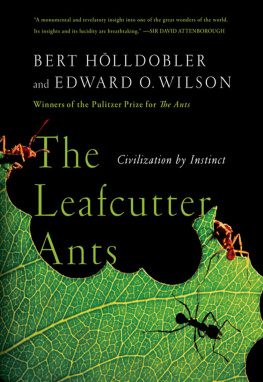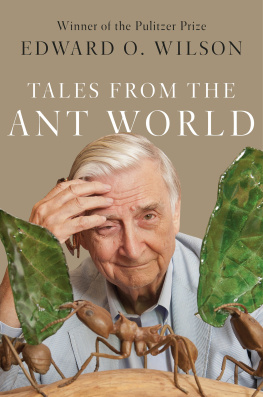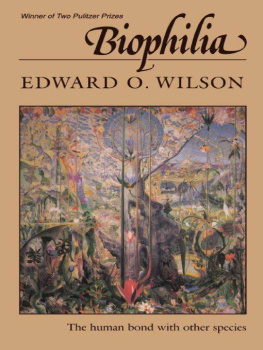Edward O. Wilson - Journey to the Ants: A Story of Scientific Exploration [1994]
Here you can read online Edward O. Wilson - Journey to the Ants: A Story of Scientific Exploration [1994] full text of the book (entire story) in english for free. Download pdf and epub, get meaning, cover and reviews about this ebook. publisher: Birkhäuser Verlag/Springer, genre: Romance novel. Description of the work, (preface) as well as reviews are available. Best literature library LitArk.com created for fans of good reading and offers a wide selection of genres:
Romance novel
Science fiction
Adventure
Detective
Science
History
Home and family
Prose
Art
Politics
Computer
Non-fiction
Religion
Business
Children
Humor
Choose a favorite category and find really read worthwhile books. Enjoy immersion in the world of imagination, feel the emotions of the characters or learn something new for yourself, make an fascinating discovery.

- Book:Journey to the Ants: A Story of Scientific Exploration [1994]
- Author:
- Publisher:Birkhäuser Verlag/Springer
- Genre:
- Rating:3 / 5
- Favourites:Add to favourites
- Your mark:
- 60
- 1
- 2
- 3
- 4
- 5
Journey to the Ants: A Story of Scientific Exploration [1994]: summary, description and annotation
We offer to read an annotation, description, summary or preface (depends on what the author of the book "Journey to the Ants: A Story of Scientific Exploration [1994]" wrote himself). If you haven't found the necessary information about the book — write in the comments, we will try to find it.
Journey to the Ants: A Story of Scientific Exploration [1994] — read online for free the complete book (whole text) full work
Below is the text of the book, divided by pages. System saving the place of the last page read, allows you to conveniently read the book "Journey to the Ants: A Story of Scientific Exploration [1994]" online for free, without having to search again every time where you left off. Put a bookmark, and you can go to the page where you finished reading at any time.
Font size:
Interval:
Bookmark:
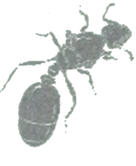 TO THE
TO THEANTS
O U R PASSION IS ANTS, and our scientific discipline is myrmecology. Like all myrmecologists - there are no more than five hundred in the world - we are prone to view the Earths surface idiosyncratically, as a network of ant colonies. We carry a global map of these relentless little insects in our heads. Everywhere we go their ubiquity and predictable natures make us feel at home, for we have learned to read part of their language and we understand certain designs of their social organization better than anyone understands the behavior of our fellow humans. We admire these insects for their independent existence. Ants carry on in the midst of the shifting wreckage created by people, seeming not to care whether humans are present or not, so long as a little piece of minimally disturbed environment is left for them to build a nest, to search for food, and thereby to multiply their kind. City parks in Aden and San Jose, the steps of a Mayan temple at Uxmal, and a gutter in the streets of San Juan are among our research sites of past years, where on hands and knees we watched these minute creatures, unaware of our presence but the objects of our own lifelong curiosity and esthetic pleasure.
The abundance of ants is legendary. A worker is less than one-millionth the size of a human being, yet ants taken collectively rival people as dominant organisms on the land. Lean against a tree almost anywhere, and the first creature that crawls on you will probably be an ant. Stroll down a suburban sidewalk with your eyes fixed on the ground, counting the different kinds of animals you see. The ants will win hands down - more precisely, fore tarsi down. The British entomologist C. B. Williams once calculated that the number of insects alive on earth at a given moment is one million trillion (1018). If, to take a conservative figure, 1 percent of this host is ants, their total population is ten thousand trillion. Individual workers weigh on average between 1 to 5 milligrams, according to the species. When combined, all ants in the world taken together weigh about as much as all human beings. But being so finely divided into tiny individuals, this biomass saturates the terrestrial environment. Thus in ways that become wholly apparent only when ones line
of sight is dropped to a millimeter of the ground surface, ants lie heavily upon the rest of the fauna and flora. They envelop the lives and direct the evolution of countless other kinds of plants and animals. Ant workers are the chief predators of insects and spiders. They form the cemetery squads of creatures their own size, collecting over 90 percent of the dead bodies as fodder to carry back to their nests. By transporting seeds for food and discarding some of them uneaten in and around the nests, they are responsible for the dispersal of large numbers of plant species. They move more soil than earthworms, and in the process circulate vast quantities of nutrients vital to the health of the land ecosystems.
By specialization in anatomy and behavior, ants fill diverse niches throughout the land environment. In the forests of Central and South America, spiny red leafcutters raise fungi on pieces of fresh leaves and flowers carried into underground chambers; tiny Acanthognathus snare springtails with their long traplike mandibles; blind, tube-shaped Prionopelta squirm deep into the crevices of decaying logs to hunt silverfish; army ants advance in teeming fan-shaped formations to sweep up almost all forms of animal life; and so on through nearly endless variations among the species in the pursuit of prey, corpses, nectar, and vegetable matter. Ants reach as far as insects can in the terrestrial environment. At one extreme, species adapted for life in the deep soil almost never come to the surface. High above them, large-eyed ants occupy the forest canopies, a few kinds living in delicate nests made of leaves bound with silk.
The dominance of ants has struck us in a particularly vivid manner during visits to Finland. In cool forests stretching north to beyond the Arctic Circle, we found that these insects still dominate the land surface. In mid-May on the southern coast, with the leaves of most of the deciduous trees still only partially emerged, the sky overcast, a light rain falling, and the temperature not rising above 12C (54 Fahrenheit, uncomfortable for scantily clothed naturalists at least), ants were active everywhere. They teemed along forest trails, atop huge moss-covered boulders, and in the grassy tussocks of bogs. In a few square kilometers could be found 17 species, one-third the known fauna of Finland.
Mound-building Formicas, red and black ants the size of houseflies ,
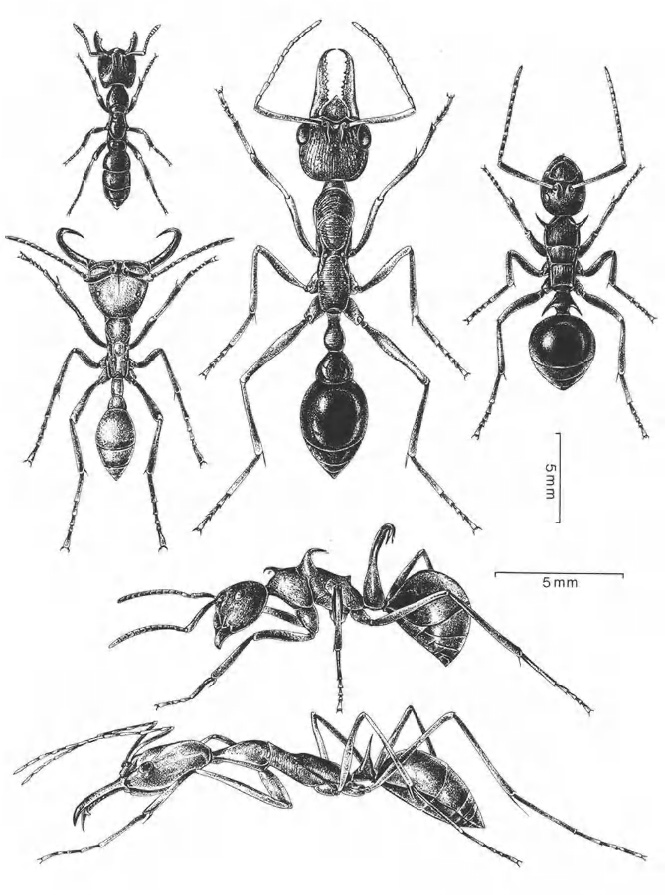
The extreme diversity of the 9,500 ant species of the world illustrated by worker ants. In the top center is a bulldog ant of the genus Myrmecia; to its left are a thick-bodied Amblyopone and a sickle-mandibled army ant of the genus Eciton. To the right of the bulldog ant is a multiple-spined Polyrhachis , and below it is another Polyrhachis and a long-mandibled Odontomachus. (Drawings by Turid Forsyth.)
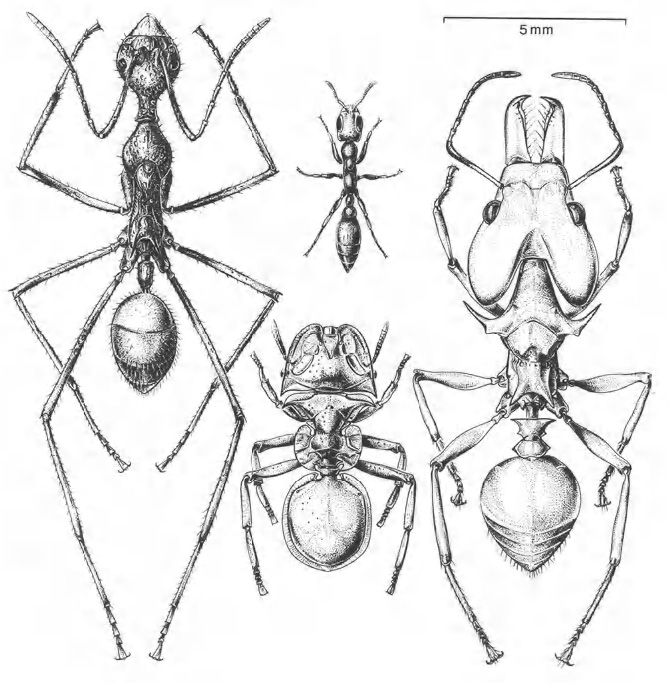
A diversity of ants from South America. On the left is a long-necked Dolichoderus; on the right is a Daceton , with spines and long trap jaws. The center ants are Pseudomyrmex at the top and a flat turtle ant , Zacryptocerus , below. (Drawings by Turid Forsyth.)
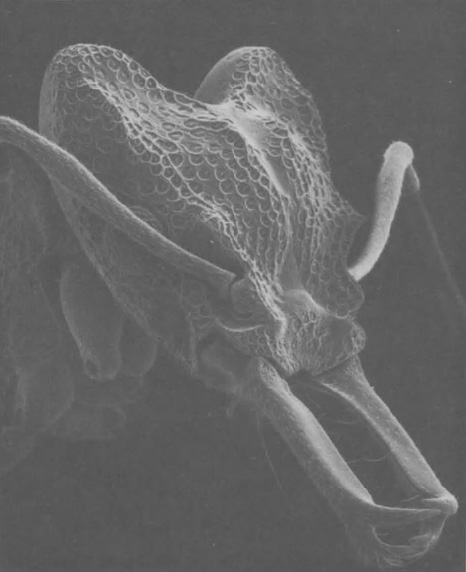

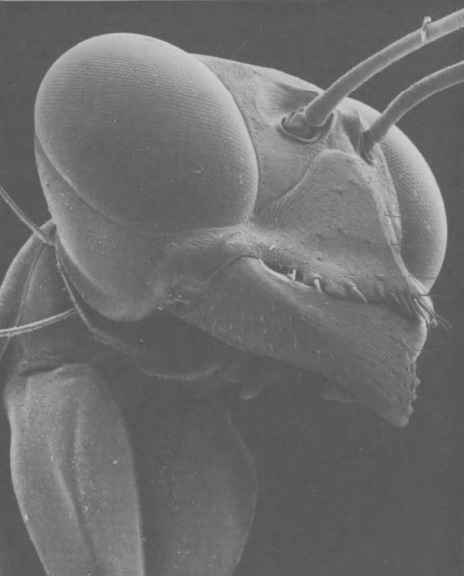
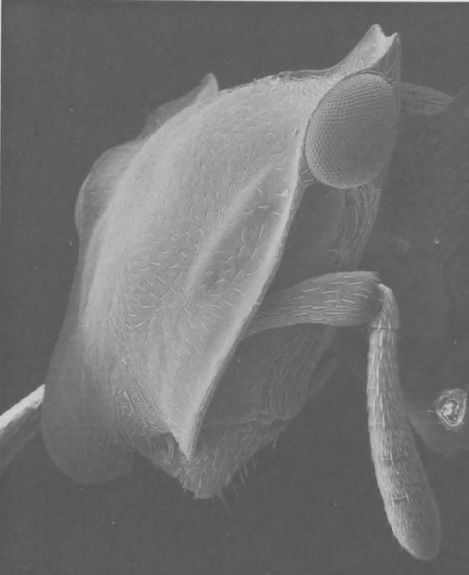
Facing page The diversity of ants illustrated by close portraits of their heads. Clockwise from the upper left: Orectognathus versicolor from Australia; Camponotus gigas from Borneo, one of the worlds largest ants; a Zacryptocerus from South America; and Gigantiops destructor from South America. (Scanning electron micrographs by Ed Seling.)
dominated the ground surface. The cone-shaped nests of several species, covered with freshly excavated soil and fragments of leaves and twigs, each housing hundreds of thousands of workers, towered a meter or more high, the equivalent for an ant of a forty-floor skyscraper. Ants seethed over the mound surfaces. They marched in columns several tens of meters long between adjacent mounds belonging to the same colony, their disciplined legions resembling heavy traffic on an intercity freeway as seen from a low-flying airplane. Other columns streamed up the trunks of nearby pine trees, where the ants attended groups of aphids and collected their sugary excrement. A small army of foragers deployed across the intervening terrain in search of prey. Some could be seen returning with caterpillars and other insects. Others were attacking colonies of smaller ants - in victory they carried the corpses of the defenders home for food.
In the forests of Finland ants are the premier predators, scavengers, and turners of soil. As we searched in company with Finnish entomologists under rocks, through the upper layers of humus, and in rotting pieces of wood strewn over the forest floor, we seldom found a patch of more than a few square meters anywhere free of these insects. Exact censuses remain to be made, but it seems likely that ants make up 10 percent or more of the animal biomass of that region.
Font size:
Interval:
Bookmark:
Similar books «Journey to the Ants: A Story of Scientific Exploration [1994]»
Look at similar books to Journey to the Ants: A Story of Scientific Exploration [1994]. We have selected literature similar in name and meaning in the hope of providing readers with more options to find new, interesting, not yet read works.
Discussion, reviews of the book Journey to the Ants: A Story of Scientific Exploration [1994] and just readers' own opinions. Leave your comments, write what you think about the work, its meaning or the main characters. Specify what exactly you liked and what you didn't like, and why you think so.








